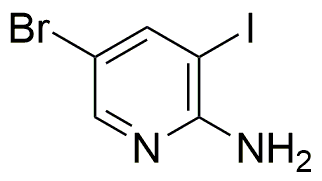2-Amino-5-bromo-3-iodopyridine is widely utilized in research focused on:
- Pharmaceutical Development: This compound serves as a key intermediate in the synthesis of various pharmaceuticals, particularly those targeting neurological disorders, due to its unique halogenated structure that enhances biological activity.
- Material Science: It is used in the development of advanced materials, such as organic semiconductors, where its electronic properties can be exploited to create more efficient devices.
- Biochemical Research: Researchers employ this compound to study enzyme interactions and mechanisms, providing insights that can lead to the development of new therapeutic agents.
- Agricultural Chemistry: It has applications in the formulation of agrochemicals, particularly in creating effective herbicides and pesticides that target specific plant pathways.
- Analytical Chemistry: The compound is utilized as a reagent in various analytical techniques, aiding in the detection and quantification of other chemical substances in complex mixtures.
General Information
Properties
Safety and Regulations
Applications
2-Amino-5-bromo-3-iodopyridine is widely utilized in research focused on:
- Pharmaceutical Development: This compound serves as a key intermediate in the synthesis of various pharmaceuticals, particularly those targeting neurological disorders, due to its unique halogenated structure that enhances biological activity.
- Material Science: It is used in the development of advanced materials, such as organic semiconductors, where its electronic properties can be exploited to create more efficient devices.
- Biochemical Research: Researchers employ this compound to study enzyme interactions and mechanisms, providing insights that can lead to the development of new therapeutic agents.
- Agricultural Chemistry: It has applications in the formulation of agrochemicals, particularly in creating effective herbicides and pesticides that target specific plant pathways.
- Analytical Chemistry: The compound is utilized as a reagent in various analytical techniques, aiding in the detection and quantification of other chemical substances in complex mixtures.
Documents
Safety Data Sheets (SDS)
The SDS provides comprehensive safety information on handling, storage, and disposal of the product.
Product Specification (PS)
The PS provides a comprehensive breakdown of the product’s properties, including chemical composition, physical state, purity, and storage requirements. It also details acceptable quality ranges and the product's intended applications.
Certificates of Analysis (COA)
Search for Certificates of Analysis (COA) by entering the products Lot Number. Lot and Batch Numbers can be found on a product’s label following the words ‘Lot’ or ‘Batch’.
Numéro de catalogue
Numéro de lot/série
Certificates Of Origin (COO)
This COO confirms the country where the product was manufactured, and also details the materials and components used in it and whether it is derived from natural, synthetic, or other specific sources. This certificate may be required for customs, trade, and regulatory compliance.
Numéro de catalogue
Numéro de lot/série
Safety Data Sheets (SDS)
The SDS provides comprehensive safety information on handling, storage, and disposal of the product.
DownloadProduct Specification (PS)
The PS provides a comprehensive breakdown of the product’s properties, including chemical composition, physical state, purity, and storage requirements. It also details acceptable quality ranges and the product's intended applications.
DownloadCertificates of Analysis (COA)
Search for Certificates of Analysis (COA) by entering the products Lot Number. Lot and Batch Numbers can be found on a product’s label following the words ‘Lot’ or ‘Batch’.
Numéro de catalogue
Numéro de lot/série
Certificates Of Origin (COO)
This COO confirms the country where the product was manufactured, and also details the materials and components used in it and whether it is derived from natural, synthetic, or other specific sources. This certificate may be required for customs, trade, and regulatory compliance.


